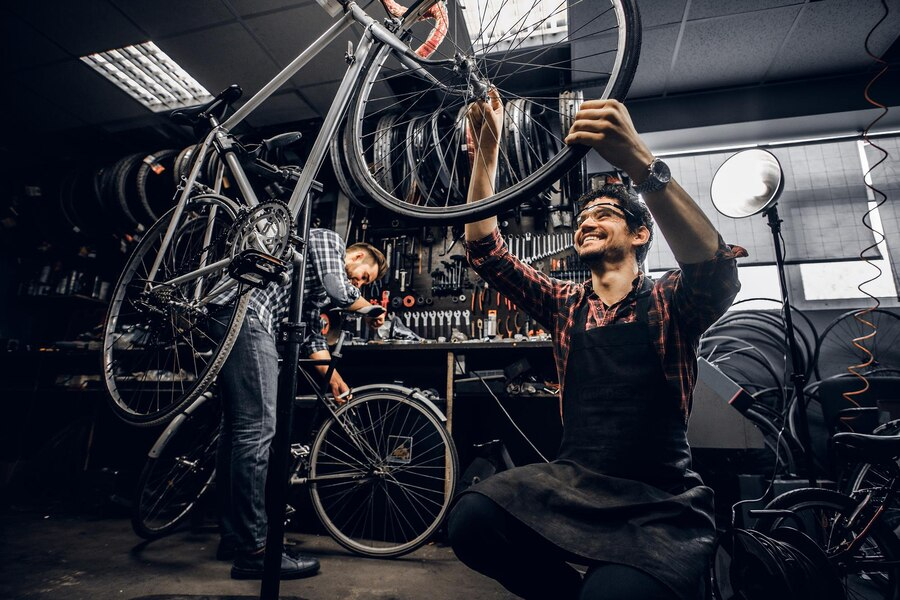Owning a bike is not just about the joy of riding; it’s also about the responsibility of maintenance. Whether you’re a seasoned cyclist or a casual rider, mastering bike maintenance is crucial for keeping your ride safe, efficient, and enjoyable. In this comprehensive guide, we’ll explore essential tips and techniques to ensure your bike stays in top condition, allowing you to enjoy many miles of smooth and trouble-free riding.
Understanding Your Bike:
Before delving into maintenance procedures, it’s essential to have a basic understanding of your bike’s anatomy. Familiarize yourself with the various components such as the frame, wheels, drivetrain, brakes, and suspension (if applicable). Knowing how these parts work together will help you diagnose problems and perform maintenance tasks more effectively.
Regular Cleaning:
Regular cleaning is the cornerstone of bike maintenance. Dirt, grime, and debris can accumulate on your bike, leading to premature wear and tear. Use a mild detergent and water to clean the frame, wheels, drivetrain, and other components. Pay special attention to hard-to-reach areas such as the cassette, chainrings, and derailleurs. After cleaning, dry your bike thoroughly to prevent rust and corrosion.
Lubrication:
Proper lubrication is essential for smooth operation and longevity of your bike’s moving parts. Apply lubricant to the chain, derailleur pulleys, cables, and pivot points of brakes and derailleurs. However, avoid over-lubricating as excess lubricant can attract dirt and cause more harm than good. Wipe off any excess lubricant to keep your bike clean and efficient.
Checking Tire Pressure:
Maintaining the correct tire pressure is crucial for optimal performance and safety. Use a quality tire pressure gauge to check the pressure regularly, especially before long rides. Under-inflated tires can increase rolling resistance and risk of pinch flats, while over-inflated tires can lead to a harsh ride and reduced traction. Refer to the sidewall of your tires for recommended pressure levels and adjust accordingly.
Inspecting Brakes:
Brake maintenance is paramount for safe riding. Inspect brake pads for wear and replace them if they are worn down beyond the recommended limit. Ensure that brake cables are properly tensioned and that the brakes engage smoothly and effectively. Additionally, check for any signs of brake rotor warping or contamination, and address these issues promptly to maintain optimal braking performance.
Drivetrain Maintenance:
The drivetrain components, including the chain, cassette, chainrings, and derailleurs, are subjected to significant wear and tear during cycling. Regularly clean and lubricate the chain to prevent corrosion and ensure smooth shifting. Monitor chain wear using a chain wear indicator tool and replace the chain before it stretches excessively, which can accelerate wear on other drivetrain components.
Wheel Maintenance:
Wheels play a critical role in the performance and safety of your bike. Periodically check for loose or broken spokes and ensure that the wheels are true and properly tensioned. Inspect the wheel bearings for smooth rotation and replace them if they feel rough or gritty. Additionally, keep an eye on tire wear and replace tires when the tread becomes worn down or when sidewall damage is evident.
Suspension Setup and Maintenance:
If your bike is equipped with suspension forks or rear shocks, proper setup and maintenance are essential for optimal performance and comfort. Follow the manufacturer’s recommendations for suspension setup, including sag settings and rebound damping adjustments. Periodically clean and lubricate suspension seals to prevent stiction and ensure smooth operation. Consider having your suspension serviced by a professional mechanic annually or as recommended by the manufacturer.
Frame Inspection:
Regularly inspect your bike’s frame for signs of damage or fatigue, such as cracks, dents, or paint chips. Pay particular attention to areas prone to stress, including welds, tube junctions, and areas around cable guides. If you notice any structural issues, have your bike inspected by a qualified mechanic to assess the extent of the damage and determine if repairs are necessary.
Professional Tune-Ups:
While basic maintenance tasks can be performed at home with the right tools and knowledge, certain tasks may require the expertise of a professional bike mechanic. Consider scheduling regular tune-ups at your local bike shop to address more complex issues such as wheel truing, bottom bracket servicing, and headset adjustment. A professional tune-up can help prolong the lifespan of your bike and ensure that it performs at its best.
Conclusion:
Mastering bike maintenance is a rewarding endeavor that not only prolongs the lifespan of your bike but also enhances your riding experience. By following these essential tips and techniques, you can keep your bike in top condition and enjoy many miles of trouble-free riding. Remember to prioritize safety, stay proactive with maintenance tasks, and seek professional assistance when needed. With proper care and attention, your bike will continue to be a reliable companion on all your cycling adventures.
